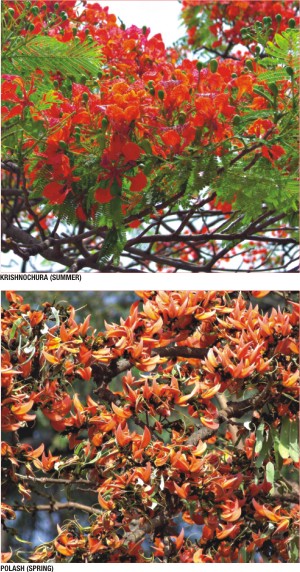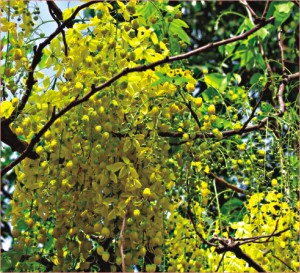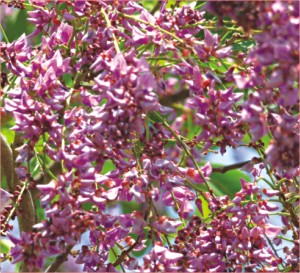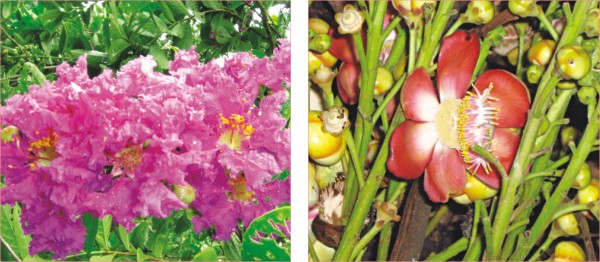
Inside
|
 KASHFUL (AUTUMN)
KASHFUL (AUTUMN)
Colourful Six Cities of Six Seasons
MOKARAM HOSSAIN delves into the exuberant beauty of our seasonal
flowers and proposes ways to build six cities marked by their unique floral varieties.
Photo: Mokaram Hossain
 |
We who work on nature cherish a dream. The dream is about a flower festival like the Cherry Festival in Japan. Bangladesh can have a flower festival in summer. The sole reason for choosing summer is that a variety of colourful flowers bloom in tall tress in this season. Another dream has been added recently: six colourful cities of six seasons. To put it simply, we would like to have six cities based on the floral features of six seasons. We already have the administrative facilities for the purpose. The six divisional towns can be the towns of six seasons. Though the seasonal flowers will get preference, trees have to be selected in a way that the town does not look dull in other seasons. The seasonal flowers will dominate most of the places but there will be a mixture of trees that do not bear seasonal flowers. In this case, our practical experience in terms of selecting shade trees has to be utilised. The local experience should also be taken into consideration. We have to make sure that the towns do not look bare and dull in other seasons. In Bangladesh, flowers of various colours bloom in abundance in all seasons. We could plant these colourful flowers in the right place. Now let us see how we can enrich our divisional towns with seasonal flowers.
Dhaka :
The capital Dhaka will be a city of six seasons and it will have a mixture of all the seasons. All we need to do is a couple of new avenues which will help create colour variations. The city parks can be arranged in that way. A few new parks can also be built. If neither of them is possible, some colourful flower trees can be planted in the existing parks. All it takes is proper planning and focus. If field level workers on nature and environment are engaged in this project it will be more effective. It will be best to plant flower bearing trees of all seasons in between tall buildings. It will ensure a colorful city around the year. Apart from this, the city parks badly need a facelift. A concerted effort is also needed to halt the haphazard erection of tall buildings to help create a balanced and beautiful natural environment.
 |
|
| SHONALU (SUMMER) | |
 |
|
| MILLETIA (SUMMER) |
Our airport road is a lot more artistic now than it was in the past. The water bodies beside the roads are in a bad shape. It would be a wonderful idea to plant aquatic flowers there. These water bodies can be turned into attractive lakes as well. Thanks to modern gene technology there is almost an inexhaustible range of colours. Besides, the number of perennial flowers is no less. These flowers can be planted in Dhaka as well. The Bougainvilleas can play a big role in this. Generally tall and long-lasting ones should get preference in building seasonal towns.
Dhaka requires some additional jobs in order to become a healthy metropolis where the roads and avenues are sufficiently flanked by greenery. This densely populated and largely unplanned city has a tremendous lack of coordination. Nor has it any long-term future plan. Apparently the footpaths of Dhaka city may look full of trees, but their number is really small. If you go out in a hot and humid day, you will realise how urgently this city needs trees.
However, Dhaka can still be rebuilt as a green city. The public and private places including the footpaths have to be brought under fresh plantation. The same is applicable to the graveyards and cremation sites of the city. Recently an organisation of architects has taken this initiative. They have decided to plant trees all over the city with preference to the indigenous variety and it is quite practical. Kolkata recently has grown to be a lot greener. They have planted trees even on narrow footpaths and there is hardly any road without trees. This venture, surprisingly, is only ten years old.
Robert Louis Proudlock, one of the Gardeners of Kew Garden took an initiative of building a green environment putting Ramna area in the centre. Unfortunately, nothing remains of that initiative. Dhaka would not have been this bare had his plans materialised.
Some Relevant Information:
The area of Dhaka is 1463.60 sq kms. It is surrounded by Gazipur and Tangail in the north, Munshiganj and Rajbari in the south, Narayanganj in the east and Manikganj in the west. The annul average rainfall is 2376 mm. Dhaka lies 23-42 and 23-54 north axis and 90 degree 20 mines and 90 degree 28 mines east axis. There are three distinct seasons: winter (November- February) with temperatures between 10-20 degrees, pre monsoon (March- May) with infrequent rainfall with a rise in temperature up to 40 degree Celsius, and the monsoon with very damp and a temperature within 30 degree Celsius.
Barisal:
Barisal can be a potential city for summer. Since this town is surrounded by rivers, the summer flowers will create a different aura. Then there are also water tolerant plant species in Barisal, which will enhance its beauty. The right spots has to be selected carefully with artistic eyes. The colour of nature in summer is inexhaustible and diverse. The trees of this season are of medium to tall height. That is why a spot that can be seen from afar has to be selected so that one feels the nature here is summer-oriented. The prominent flowers of summer are Jarul, Sonalu, Krisnachura, Pakhiphul, Sornochampa, Jakaranda, Peltofourm, Gulachi. There can be a few avenues of Jarul and Krisnachura to create a variety in colour. There can be one avenue or two of Sornochampa and Jakaranda of bluish violet colour. These trees are remarkable not only for their shape but also for their flowers. Peltophorum or Kurchi might have separate avenues. Gulachi these days are of various colours and grow naturally. They don't require any extra attention. This tree can be planted in a rapid scale if spaces are available. The presence of Lily, Orchid, Gladiolus, Helycunia, Bely, Combretum, Sada Ronggon, Gulnargis, Gondhoraj etc. in parks or in the educational institutions will add a different dimension. There can be a lively presence of golden or yellow lilies in the reserved water bodies.
Some relevant information:
The area of Barisal is 2790.51 sq kilometers. It is surrounded by Madaripur, Chandpur and Shariatpur in the north; Patuakhali, Jhalakathi, and Barguan in the south; Bhola and Laxmipur in the east and Jhalkathi, Pirojpur and Gopalganj in the west. The highest annual temperature is 35.1 degree Celsius and the lowest temperature is12.1 degree Celsius. The annual rainfall is 1955mm.)
 |
|
| KONOKCHAMPA (SPRING) | RAJASHOK (AUTUMN) |
 |
|
| SHEULI (AUTUMN) | NAGESHWER (SPRING) |
Sylhet:
Sylhet can be a town of the monsoon. Adjacent to Assam, this region experiences a lot of rainfall. This town can be a town of Dulichapa (Magnolia pterocarpha) as well since it is the only wild magnolia of this region. The private and public nurseries can be the suppliers of the plants. The greater Sylhet is dotted by a lot of water bodies which are filled with a host of aquatic flowers in monsoon. Lotus is one of the dominant flowers of this region. Besides, there are lilies and Shaluk and Chadmala of various species. Apart from this, the natural beauty of Sylhet can be put to good use.
We should also find out the flowers that bloom in the hills in monsoon. The list of monsoon flowers is quite long. There can be a pretty long avenue of Kodom and Sultanchanpa and canon ball trees. Hijalas can be planted by the Beels (marshes). In public places there can be Chalta and in the open spaces of different organisations there can be Kolkey and Kamini. A few Jaruls other than the common variety bloom in the monsoon. There can be an avenue of Bilati Jarul and recently imported lazar of bright violet. It can be mixed with Crab and Furush. The other creepers of monsoon like Maloti, Jhumko, Dolonchanpa, Kanthalichampa, Hasnahena, Sonapati, Ulotcondal, Oporajita, Korobi will make the beauty of monsoon accessible to all.
 |
|
| CHALTA (MONSOON) | DULICHAMPA (SUMMER) |
 |
|
| JARUL (SUMMER) | PAKHIFUL (SPRING) |
Some relevant information :
The area of Sylhet is 3,490.40 sq km. Sylhet is flanked by Khasia Jointia hills in the east, Moulovibazar in the south, Kachad and Karimganj Of India in the east, and Sunamganj and Hobiganj in the west. The highest annual average temperature is 33.2 degree Celsius, the lowest is 13.6 degrees. The annual gross rainfall is 3334 mm. Total reserve forest is 236.42 sq km. Part of Khasia and Jaintia hill lies to the north-east of Sylhet. Among the small hills and hillocks are Jaintapur hillock (54 m), Shari Tila (92), Lalakhan Hillock(135) and, the hillocks of Dhaka south (77.7 m) etc.)
Khulna:
Khulna can be a dream town of Autumn. The bright blue sky of this season creates a soothing feeling in mind. If the beauty of the Sundarbans is added with this, it will be a wonderful city. A separate festival can be arranged in the Sundarbans, the world heritage site. The list of autumn flowers is not long yet if planted with careful planning and an aesthetic sense, a beautiful Khulna can be carved out. A large water body or a riverside can be chosen for what there will be Kash close by and Sheuli on a relatively higher place. A few monsoon flowers linger up till autumn. These can be brought in the town of autumn. Lotus can be planted in rapid scale in the water bodies. The beauty of lotus in the autumn is unique. Bokful of different colours may also be chosen for some places. Dupurmoni and Land lily will add to the beauty in the parks and open spaces.
Some relevant information :
The area of Khulna is 4394.46 sq kms. Khulna is surrounded by Nadail and Jessore in the north, the Bay of Bengla in the south, Bagerhat in the east, and Satkhira in the west. The highest annual temperature is 35.5 degree Celsius and the lowest is 12.5 degree Celsius. Annual average rainfall is 1710 mm. The largest mangrove forest, the Sundarbans, is situated in this division, covering 1,66,814 hectares of land.
Rajshahi :
Rajshahi can be both a town of late autumn and winter. North Bengal is the threshold of winter in our country. The harvest festival of late autumn, the fog, arrival of the migratory birds- all have very special appeal in our minds. The silence of a misty night arouses a unique feeling in our minds. The flowers of late autumn partly contribute to those feelings. We can easily mingle that beauty with autumn nature. Late autumn signals winter when the trees prepare to shed leaves. A few flowers surprise us in this season. The autumn flowers can be planted on both sides of the highways. Thus a new beauty can be created from the existing nature. The major flowers of this season are Himjhuri or Akashneem, Debkanchan Chateem etc. while the minor flowers are Dharmara or Peetpatla, Rajashok and Bonoakra etc.
There can be pretty big avenue with Devkanchon alone. Side by side, some tall trees have to be chosen for winter. There can be individual or joint avenues of Babla, Khoyer, Minjiri with a lot of Acacia, Bilayana, Dicarance, Doratoxilon, Filisifolia etc. The saplings of these trees are not rare these days. The temperature remains pretty low here. This city can be decorated with numerous winter flowers. Apart from the seasonal flowers, some perennial flowers are also seen in our country which will help create durable natural beauty. The gardens of seasonal flowers, however, are not part of durable nature; they are just an accessory and their beauty can only be considered as transient. In addition to the seasonal flowers, there can be perennial creepers like Rosundi, the rare flower Sorno Asoka, Rose cactus, Sohosro bely, Camellia and golden shower can be included in the plan.
 |
|
| BEGUNI CRAB (MONSOON) | NAGLINGGOM (SUMMER-MONSOON) |
 |
|
| SHORNO ASHOK (WINTER) | DEBKANCHON (EARLY AUTUMN) |
 |
|
| STHOLPADMA (AUTUMN) | GOLDEN SHOWER (WINTER) |
 |
|
| ASHOK (SPRING) |
Some relevant information :
The area of Rajshahi is 2407.01 sq kms. This division is 34513 sq kms. It is surrounded by Naogaon in the nort; the Indian state of west Bengal, Khustia and the Ganges in the south; Natore in the east and Chanpainawabgonj in the west. This district consists of the Baring tract, Diara and Charanchals. The highest annual temperature is 37.8 degree Celsius and the lowest is 11.2 degree Celsius. The highest annual rainfall is 1862 mm. The divisional town stands on the Padma River. The largest Chalanbill is in this district.
Chittagong :
Chittagong can be a potential candidate for arranging the spring festival. The hills are very attractive. The celebration of spring festival in the lap of the hills promises a tremendous entertainment. To celebrate spring we can borrow certain plants from the hills. The major flowers that keep the spring alive are Kanakchanpa, Muchkundo, Palash, Parijat, Shimul, Gamari, Lotkonful, Milletia, Gliricidia, Golapjamful etc. There can be separate avenues with individual spring flowers. Or there can be mixed avenues as well to create a variety in colours. There are numerous hillocks across Chittagong. There can be extensive plantation of flowers in these hillocks. Our one and only magnolia, Dulichapa can be used to decorate a park or an open space. Since this tree belongs to the hilly regions of Sylhet, it will have natural growth and blooming in Chittagong. The creepers like Kontoklata, Madhobi, Nilmoni, Hapormali etc will add to the beauty of spring. The list of spring flowers, however, is very long. From the tiny grass glowers to tall Telshur , there are a host of flowers during this season.
Some relevant information :
The area of Chittagong is 5282.98 sq kms. It is surrounded by Khagrachadi and Rangamati and the Indian state of Tripura, and Cox's Bazar in the south; Bandarban, Khagrachadi and Rangamati in the east; and Noakhali and the Bay of Bengal in the west. The highest annual temperature is 33.8 degree Celsius. Annual average rainfall is 3194 mm. The three hill districts belong to this division. This city stands on the right bank of the Karnophuli River.
The six cities coloured with six seasons will add a new dimension to our emotions and festivities and above all, to our culture and identities.
Mokaram Hossain writes on nature and environment and can be reached at tarupallab@gmail.com